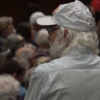April 30, 2013. The Toledo Blade.
Fifteen zip codes in the Toledo area are designated as high-risk areas for exposure to children of lead paint, and a local non-profit agency is urging city officials to adopt strategies to help prevent lead poisoning in those areas and throughout the city.
Toledoans United for Social Action hosted a meeting tonight to bring officials up to date on the many children in Toledo who are affected by living in homes where lead paint is prevalent. In 2008, 208 Toledo children were diagnosed with lead poisoning and 55 percent of children at risk for lead poisoning were not tested. More than 100 people attended the meeting, held at Friendship Baptist Church on Nebraska Ave.
“Lead is a devastating, secret, silent problem,” Robert Cole, an attorney for Advocates for Basic Legal Equality, Inc. “And the solution is not to wait.”
A map presentation by David Norris, senior researcher at The Kirwan Institute for the Study of Race and Ethnicity at Ohio State University, revealed that the central city is one of the main areas where older homes with lead paint exist.
“In Toledo, the central city especially, the housing was all pre-1970,” he said, noting that lead paint was commonly used until 1978. He said low property values, combined with the frequency of lead paint is often a recipe for disaster.
During the meeting, officials said that special education costs increase for school districts that have students who have been consistently exposed to lead paint and experience developmental issues because of it. In addition, they said, some studies have revealed correlations between exposure and negative behavior.
Mr. Norris said students who have a blood level of between 2-10 ug/dL can cause “persistent cognitive damage in children.” But when he said that “no level of lead in a child’s blood is acceptable,” the audience burst into applause.
Children with levels of lead in their blood can exhibit symptoms such as stomachache, headache, tiredness and anemia, according to the Ohio Department of Health’s Childhood Lead Poisoning Prevention Program.
The most common way children are exposed to lead is by ingesting chipped paint. Mr. Cole said children between 18 months and three years are particularly at risk.
Toledoans United for Social Action members referenced two cities – Rochester, N.Y., and Greensboro, N.C. – as examples of cities that were able to decrease lead exposure through community activism.
But the group also had a request for Mayor Michael Bell and Toledo City Council President Paula Hicks-Hudson. The organization asked that each commit to doing three things: work with Toledoans United for Social Action to develop an ordinance by Sept. 1 that would hold landlords accountable for complying and verifying that rental properties are lead-safe; meet with the group within 30 days, and also attend the annual conference in November.
Both accepted the challenge.
Mayor Bell said finding ways to help landlords pay for abatements on rental houses that contain lead is crucial to making the ordinance work effectively.
“This is not just an issue for this group. This is an issue for the community,” he said. He said he would like to work to find solutions that won’t compromise housing for families who rent.
Ms. Hicks-Hudson also encouraged the value of planning ahead.
“It’s easy to pass legislation, but the implementation is going to require a lot of work and ingenuity,” she said. Councilmen Shaun Enright and Joe McNamara, Deputy Mayor Steve Herwat and officials from Toledo Public Schools, including interim superintendent Romules Durant, also attended the meeting.





